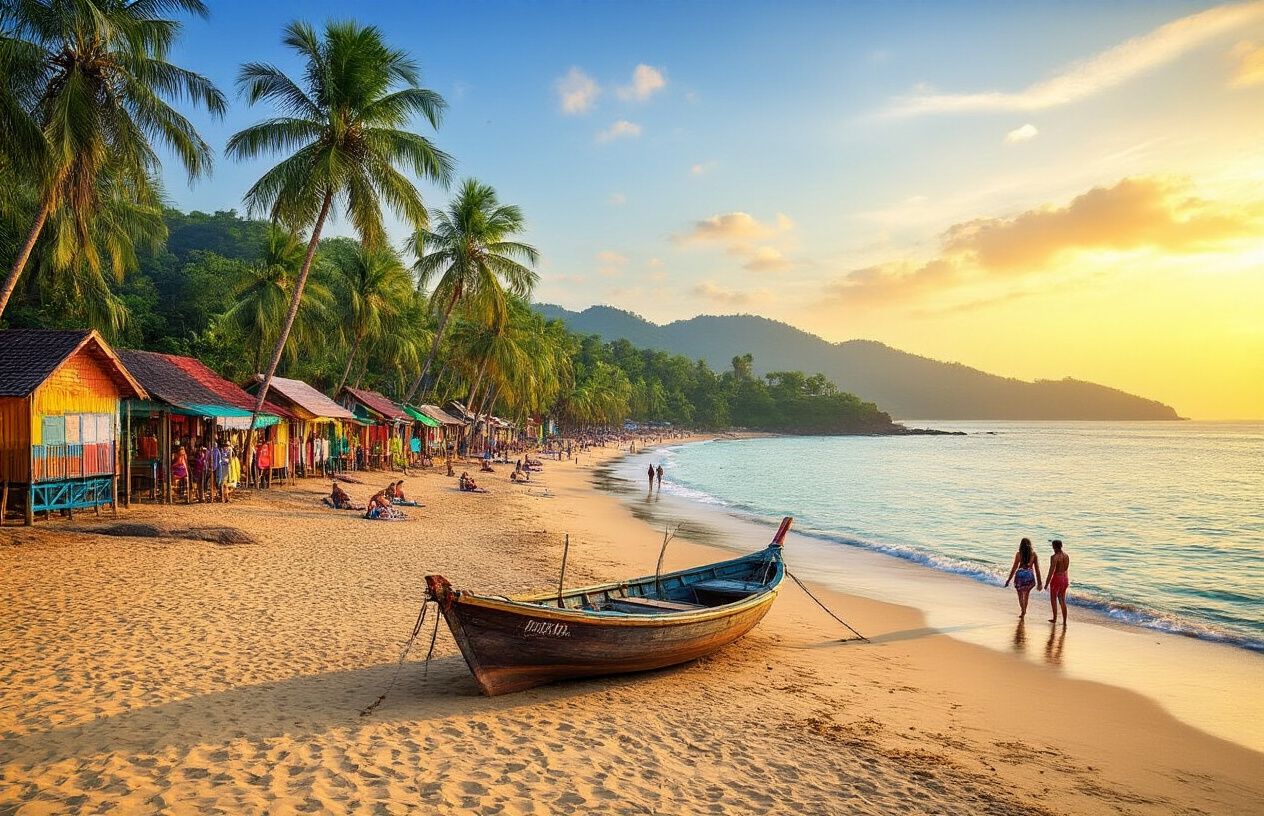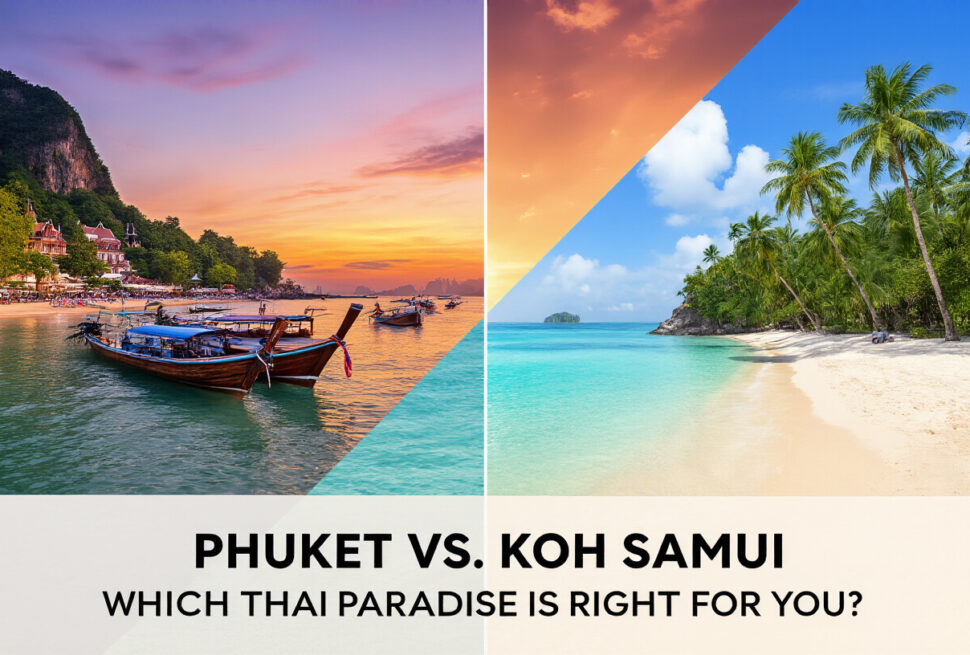Ever dreamed of sipping coconut water on a sun-kissed beach, but get anxiety about timing your trip wrong? You’re not alone. Nothing kills vacation vibes faster than monsoon floods washing away your beach day plans in Goa.
Let me save you from that disaster. This guide gives you exactly when to book your flight and which Goan gems to prioritize when you land.
The best season to visit Goa isn’t actually when most people think. Between November and February, this coastal paradise transforms with perfect 75-85°F days, minimal rain, and vibrant markets that aren’t suffocatingly crowded.
But here’s what nobody tells you about timing your Goa adventure – there’s a secret two-week window that offers all the perks of peak season at nearly half the price…
Best Seasons to Visit Goa
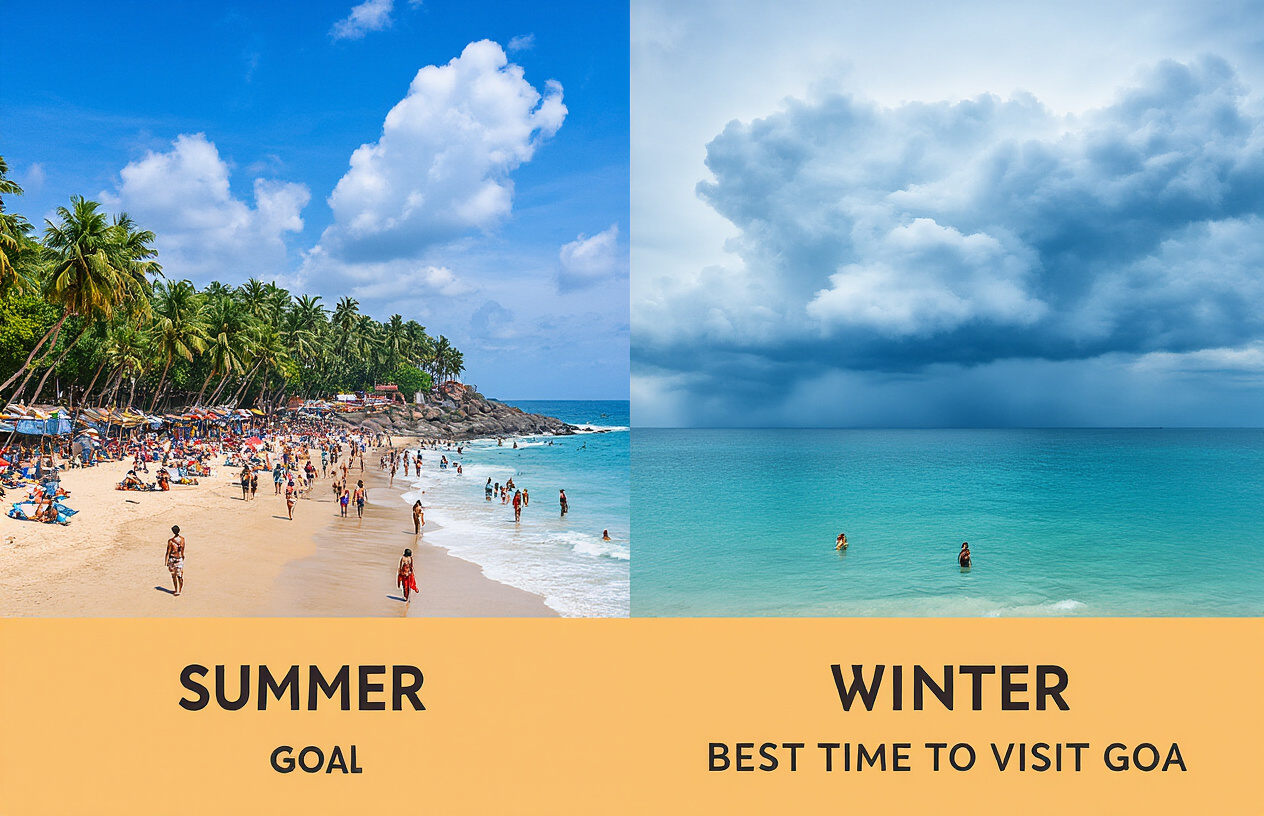
A. Peak Season (November to February): Perfect Weather and Festivities
Goa in winter? Pure magic. The temperatures hover between 25-30°C during the day and cool off to a pleasant 15-20°C at night. No sweat-soaked shirts or melting makeup – just perfect beach weather.
This is when Goa truly comes alive. The beaches are buzzing, shacks are set up along the shoreline, and the party scene kicks into high gear. You’ll find yourself dancing under the stars at beach parties one night and exploring night markets the next.
December brings Christmas and New Year celebrations that are off the charts. The streets light up with decorations, churches host midnight mass, and fireworks paint the sky. But fair warning – everyone wants to be in Goa during this time, so prices skyrocket and crowds are inevitable.
B. Monsoon Season (June to September): Lush Landscapes and Budget Travel
Rain transforms Goa into a different world altogether. The dusty roads give way to lush greenery, waterfalls spring to life, and the Western Ghats look like they’re straight out of a movie.
Most tourists avoid monsoon season, which means you’ll score incredible deals on hotels (sometimes 50-70% off peak season rates). Imagine having Goa’s famous beaches almost to yourself – just you and the dramatic views of storm clouds gathering over the Arabian Sea.
Sure, some beach shacks close down, and water sports take a back seat, but monsoon Goa offers unique experiences – spice plantation tours surrounded by mist, Dudhsagar Falls at full throttle, and hot cups of chai at empty beachfront cafés.
C. Shoulder Season (March to May): Less Crowded Beaches and Lower Rates
Summer in Goa brings the heat – we’re talking 33-35°C and high humidity. But don’t write it off just yet.
The crowds thin out dramatically after March. That beach spot that required an early morning towel-placing mission in December? All yours now. Hotels drop their rates by 30-40%, and you can actually get tables at popular restaurants without reservations.
The ocean is calmer and clearer now – perfect for snorkeling and diving. Plus, the mangoes are in season. Trust me, you haven’t lived until you’ve had a fresh Alphonso mango from a Goan market.
D. Festival Calendar: When to Catch Goa’s Famous Celebrations
Timing your trip around Goa’s festivals adds a whole new dimension to your vacation:
- Carnival (February/March) – Four days of parades, music, and colorful floats. The streets of Panjim transform into one big party.
- Shigmo (March) – Goa’s version of Holi with folk dances and traditional performances.
- Feast of St. Francis Xavier (December 3) – A massive celebration at Old Goa’s Basilica.
- Sunburn Festival (December end) – Asia’s biggest electronic music festival draws DJs and party-goers from around the world.
- Goa Film Festival (November) – For cinema buffs, this international festival showcases films from across the globe.
Time your visit right, and you’ll experience the cultural heart of Goa beyond just its beaches and bars.
North Goa: Vibrant Beach Experience
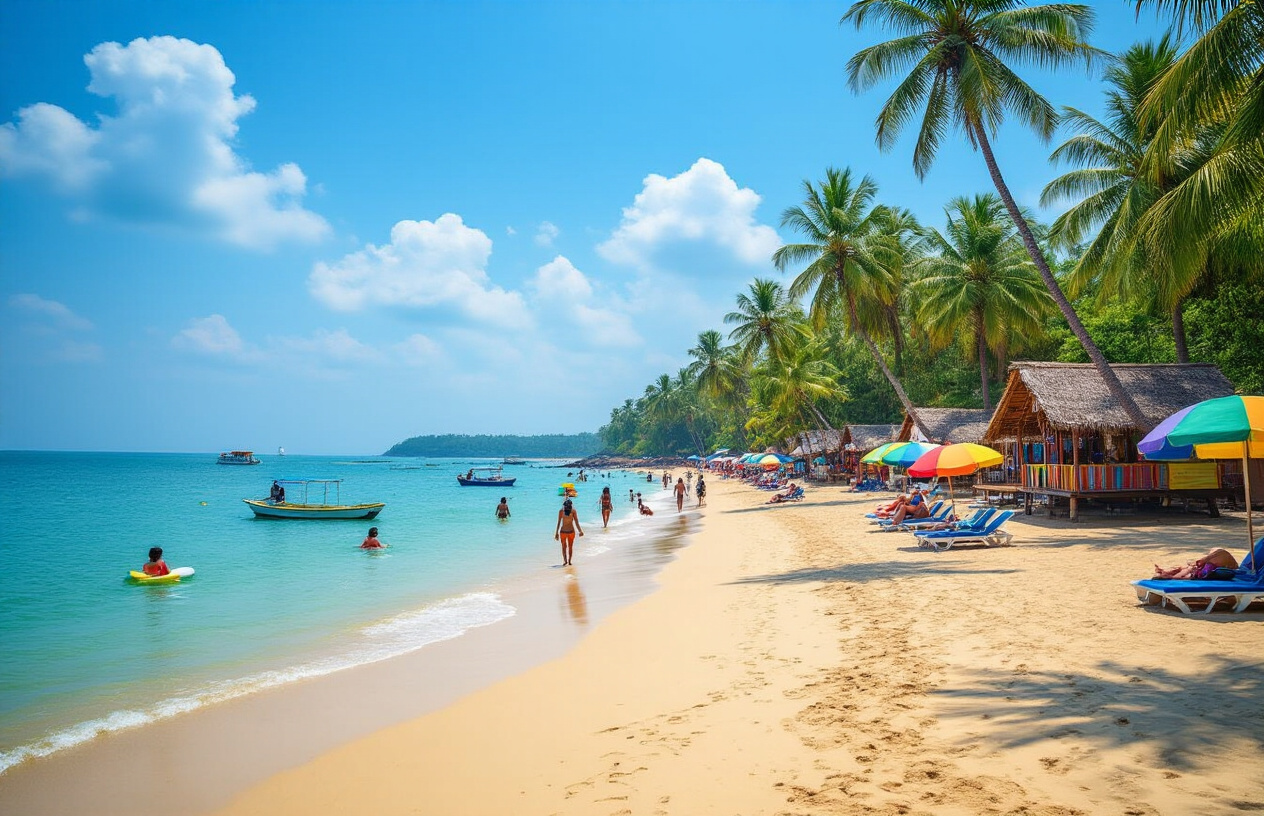
Baga and Calangute: Bustling Hotspots for Nightlife
Think Goa, think Baga and Calangute. These beaches aren’t just popular—they’re legendary. The sand stretches for miles, packed with colorful shacks serving everything from fresh seafood to ice-cold beers.
Nights here? Pure electric energy. Club Cubana, Tito’s, and Mambo’s don’t even get started until midnight. You’ll find yourself dancing until sunrise, wondering where the time went.
The crowds? Massive. But that’s part of the charm. You’ll bump into travelers from everywhere—Delhi dudes on bachelor trips, Mumbai families on weekend getaways, and foreigners escaping winter back home.
During peak season (November to February), finding accommodation without booking ahead? Good luck with that!
Anjuna and Vagator: Hippie Culture and Flea Markets
Anjuna’s Wednesday flea market isn’t just shopping—it’s an institution. Haggle for everything from Kashmiri carpets to psychedelic t-shirts while sipping fresh coconut water.
The hippie vibe never died here. It just evolved. Beach cafes like Curlies and Shiva Valley still pump trance music while barefoot travelers sway to the beats.
Vagator’s red cliffs give it this dramatic backdrop you won’t find elsewhere. The sunsets? Instagram gold. And the twin beaches (Big Vagator and Little Vagator) give you options—party or chill.
Morjim and Ashwem: Russian Influence and Turtle Nesting
Ever heard someone call Morjim “Little Russia”? One visit and you’ll understand why. Russian signs, Russian menus, Russian-owned businesses everywhere.
But the real stars here are the endangered Olive Ridley turtles. Between October and March, these creatures lumber onto the shores to nest. Watching them? Life-changing.
The vibe’s totally different from South Goa beaches—more upscale, with boutique hotels and chic beach shacks serving organic food and fancy cocktails.
Water’s cleaner here too. Perfect for swimming without dodging plastic wrappers.
Fort Aguada: Historical Marvel with Panoramic Views
Standing for over 400 years, Fort Aguada isn’t just old—it’s tough. Built by the Portuguese in 1612, it was basically unconquerable.
The lighthouse inside? Oldest in Asia. Before electricity came along, a massive oil lamp guided ships safely to shore.
The fort’s freshwater spring was so reliable that passing ships would stop to fill their reserves—hence the name “Aguada” (meaning “water” in Portuguese).
The views from up top? Breathtaking. The Arabian Sea stretches endlessly before you, with North Goa’s coastline curving beautifully in the distance.
Chapora Fort: Sunset Magic and Bollywood Fame
Remember that iconic scene from “Dil Chahta Hai”? Three friends sitting on a fort wall, contemplating life? That’s Chapora Fort.
Getting up there requires a sweaty climb, but trust me—worth every drop. The panoramic views of Vagator Beach below and Morjim across the river will make you forget your burning calves.
The fort itself is pretty much ruins now, but that adds to its charm. Less touristy than Fort Aguada, you can actually find quiet corners to sit and soak in the magic.
Sunset time? Pure gold. The sky explodes with colors while fishing boats head out for the night. Bring a camera—or better yet, just be present.
South Goa: Serene Coastal Retreats
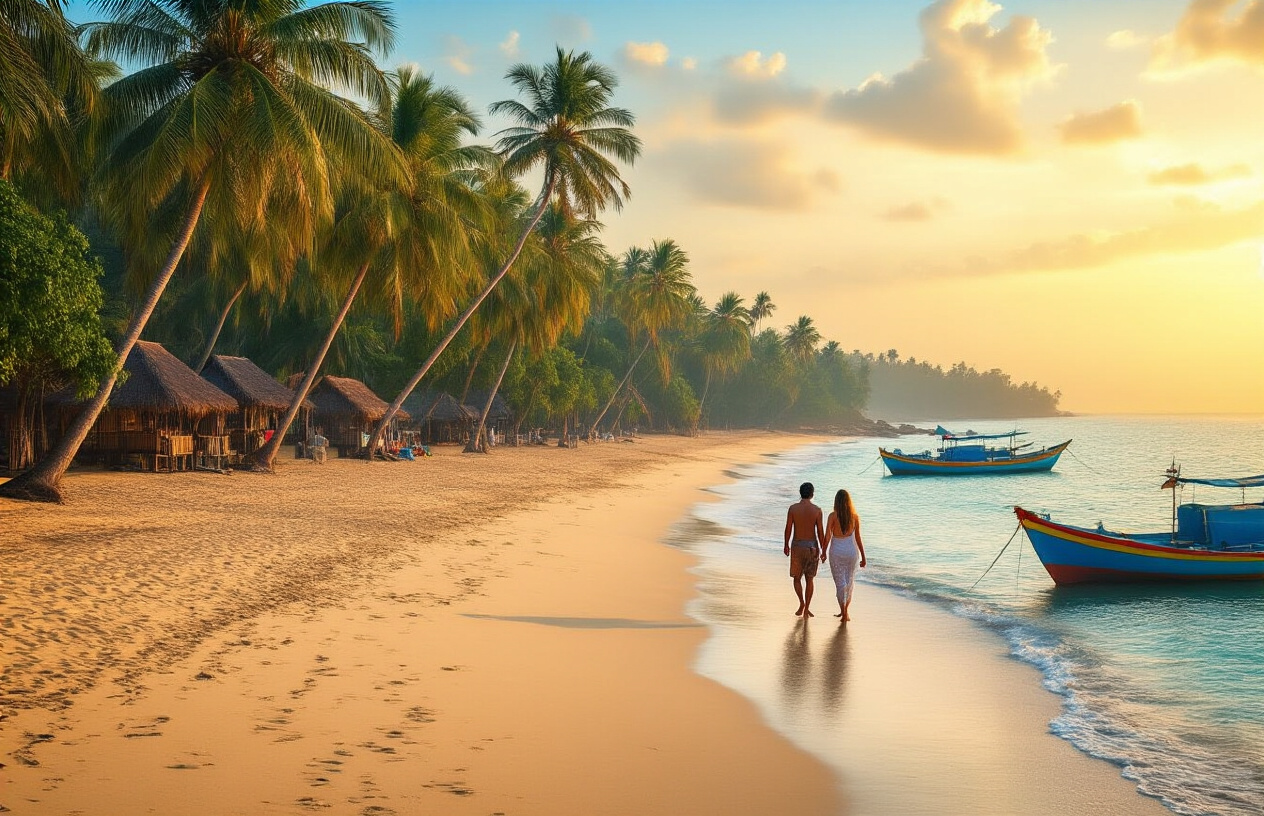
A. Palolem and Agonda: Pristine Beaches with Quiet Charm
Ever noticed how some beaches just feel different? That’s Palolem and Agonda for you.
Palolem Beach is that perfect crescent of golden sand you’ve been dreaming about. Coconut palms sway gently, colorful fishing boats dot the shoreline, and the water? Crystal clear and calm enough for even the most hesitant swimmers.
The vibe here is laid-back but with just enough going on. Beach shacks serve fresh seafood caught that morning, and accommodation ranges from basic huts to boutique stays. At night, the place transforms with silent disco parties where everyone dances to music on wireless headphones under the stars.
Agonda, just a short drive north, is Palolem’s quieter cousin. The beach stretches for nearly 2 miles with fewer people and more space to breathe. It’s a nesting site for Olive Ridley turtles, so parts of the beach remain undeveloped.
Morning yoga on Agonda’s beach has become something of a ritual for travelers seeking peace. The sunsets here? Absolutely magical – orange and pink skies reflected in wet sand as local fishermen return with their catch.
Both beaches offer a perfect escape from Goa’s more commercialized north, with October to March being ideal visiting months when temperatures hover between 77-90°F with minimal rainfall.
B. Colva and Benaulim: Family-Friendly Shores
Got kids in tow? Colva and Benaulim should top your list.
Colva Beach stretches for about 2.5 miles of powdery white sand – the longest stretch in South Goa. The shallow entry into the Arabian Sea makes it perfect for families with young children who want to splash around safely.
The beach is backed by a bustling village with affordable restaurants, ice cream stands, and souvenir shops. Unlike North Goa’s party beaches, Colva maintains a family-oriented atmosphere with plenty of space for building sandcastles or playing beach cricket.
Benaulim, just south of Colva, offers an even more relaxed family experience. The fishing village charm remains intact here, with traditional wooden boats lining the shore and fishermen mending nets in the early morning light.
What makes Benaulim special is the dolphin-watching trips that leave directly from the beach. Your kids will never forget spotting these playful creatures jumping through the waves. Water sports are available but not overwhelming – think banana boat rides rather than a constant drone of jet skis.
Both beaches have excellent seafood shacks where you can enjoy fresh catch while keeping an eye on the kids playing in the sand. The best time to visit with family is November to February when the weather is mild and perfect for beach days.
C. Butterfly Beach: Hidden Gem Accessible by Boat
Think all of Goa’s beaches have been discovered? Think again.
Butterfly Beach is that secret spot that makes you feel like a true explorer. Tucked away in a small cove between Palolem and Agonda, this half-moon shaped beach is inaccessible by road – and that’s exactly what makes it special.
To reach this hidden paradise, you’ll need to hop on a boat from Palolem (about 20 minutes) or tackle a challenging trek through dense forest. The effort? Totally worth it.
The beach got its name from the countless butterflies that flutter around the surrounding trees and plants. The water here is exceptionally clear, making it perfect for snorkeling – you’ll spot colorful fish darting between rocks just offshore.
What’s amazing about Butterfly Beach is the feeling of having discovered your own private paradise. There are no permanent structures, no shacks, no vendors – just pristine nature. The rocky outcrops at either end of the beach create natural infinity pools at low tide.
Visit during sunset for a truly magical experience – the entire cove lights up in golden hues, and if you’re lucky, you might spot dolphins playing in the distance. Just remember to bring water and snacks since there are no facilities here.
The beach is best visited between October and March when the sea is calm enough for boat trips.
Cultural Attractions Beyond Beaches
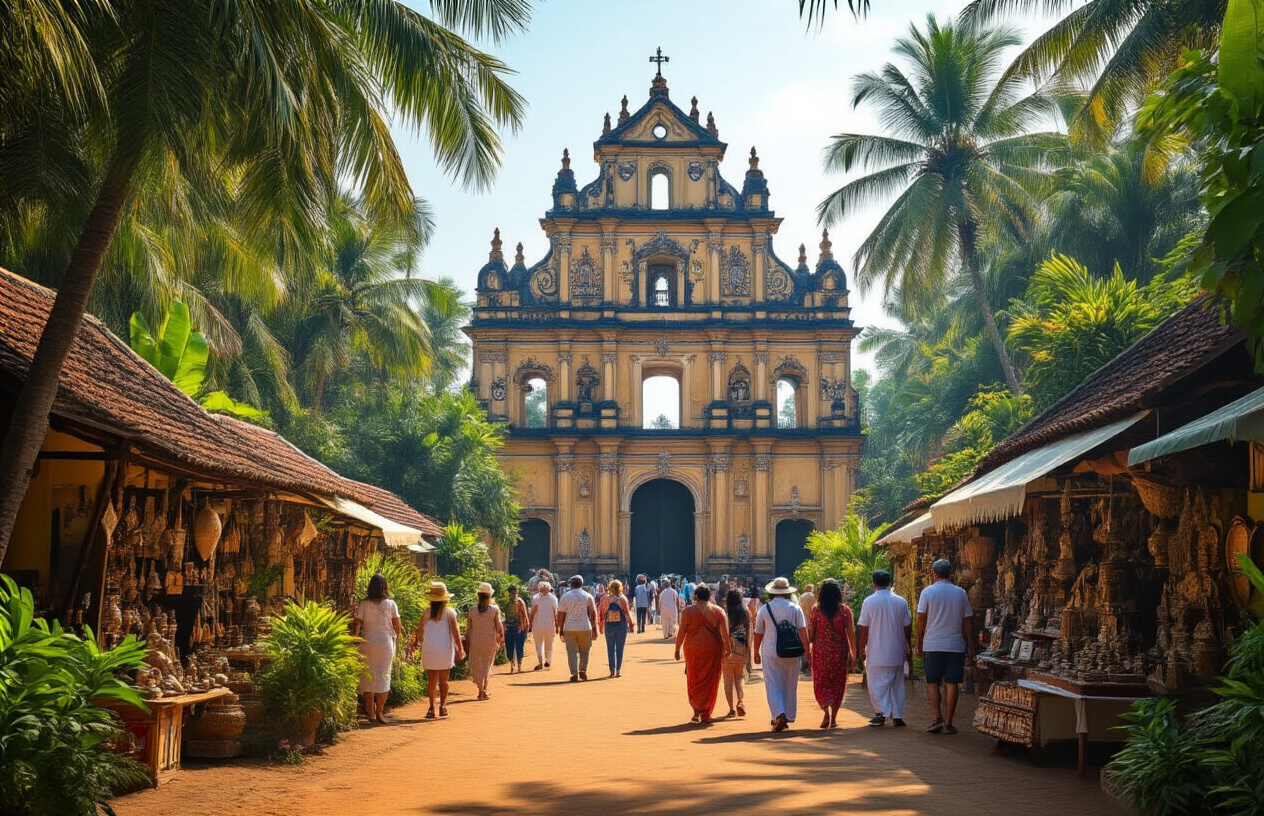
A. Old Goa Churches: UNESCO Heritage Architecture
Look, Goa isn’t just about sunbathing and beach parties. The real magic happens when you step away from the coastline and discover its jaw-dropping churches.
Old Goa’s churches will blow your mind. These aren’t your average religious buildings – they’re masterpieces that earned UNESCO World Heritage status back in 1986.
The Basilica of Bom Jesus? It’s where Saint Francis Xavier’s remains are kept in a silver casket. The church itself is a stunning example of Baroque architecture with red laterite stone that just pops against the blue sky.
Se Cathedral nearby is massive – one of Asia’s largest churches with golden altars and intricate woodwork that’ll make your jaw drop. That bell in its tower? They call it the “Golden Bell” because of its rich sound that echoes through Old Goa.
Don’t miss the Church of St. Francis of Assisi with its Tuscan exterior and ornate gilded interior. The detailed paintings telling biblical stories make it worth the visit alone.
B. Spice Plantations: Aromatic Tours and Elephant Rides
Goa’s spice plantations are a feast for your senses. The moment you step in, the air hits different – all fragrant with cardamom, cinnamon, and pepper.
Most plantations offer guided tours where you’ll walk through lush greenery spotting vanilla vines climbing up trees, cardamom pods hiding under broad leaves, and pepper corns ripening in clusters.
The guides know their stuff. They’ll show you how each spice grows and share cool medicinal uses you’d never guess. Many tours end with a traditional Goan lunch served on banana leaves – food that’s grown right there on the property.
And yes, elephant rides are a thing at some plantations. You’ll sway atop these gentle giants as they carry you through the tropical landscape. It’s not the same rush as beach paragliding, but there’s something pretty special about connecting with these animals in such a lush setting.
The Sahakari, Tropical, and Pascoal spice farms near Ponda are worth checking out. They all offer slightly different experiences, but the aromatic walks and spice shopping are guaranteed.
C. Dudhsagar Falls: Magnificent Waterfall Adventures
Dudhsagar Falls isn’t just a waterfall – it’s a four-tiered monster cascading from 310 meters up. The name means “Sea of Milk,” and once you see those white torrents crashing down, you’ll get why.
Getting there is half the adventure. Most people take the jeep safari through Bhagwan Mahavir Wildlife Sanctuary, bouncing along dirt roads and crossing streams that sometimes reach window height. The more adventurous types hike through the jungle for hours to reach it.
The best time to visit? Monsoon season (June to September) when the falls are at full throttle. The downside is sometimes they close access due to dangerous conditions. Post-monsoon (October to January) offers a solid compromise – still impressive flow but safer conditions.
Swimming in the emerald pool at the bottom with the waterfall thundering down is surreal. The area is also part of a wildlife sanctuary, so keep your eyes peeled for monkeys, butterflies, and if you’re super lucky, maybe even a distant leopard.
D. Ancestral Goa Museum: Traditional Village Life Experience
The Ancestral Goa Museum feels like a time machine. Created by local artist Maendra Jocelino Araujo Alvares, this open-air museum shows you what Goan village life was like before tourists and techno parties took over.
They call it “Big Foot” because there’s a large footprint on display that’s tied to local legends. The whole place is a carefully crafted model village with life-sized sculptures showing traditional occupations, customs, and daily routines.
You’ll see representations of cashew feni distillation (Goa’s famous liquor), traditional baking methods, and fishing techniques that have sustained coastal communities for generations.
What makes this place special is how it captures mundane village moments – women grinding spices on stone, men playing traditional games, kids engaged in forgotten pastimes – all frozen in time through artistic recreations.
Don’t miss the laterite sculpture garden with its detailed carvings and the Casa Araujo, a traditional Portuguese-Goan house filled with period furniture and household items.
Culinary Journey Through Goa
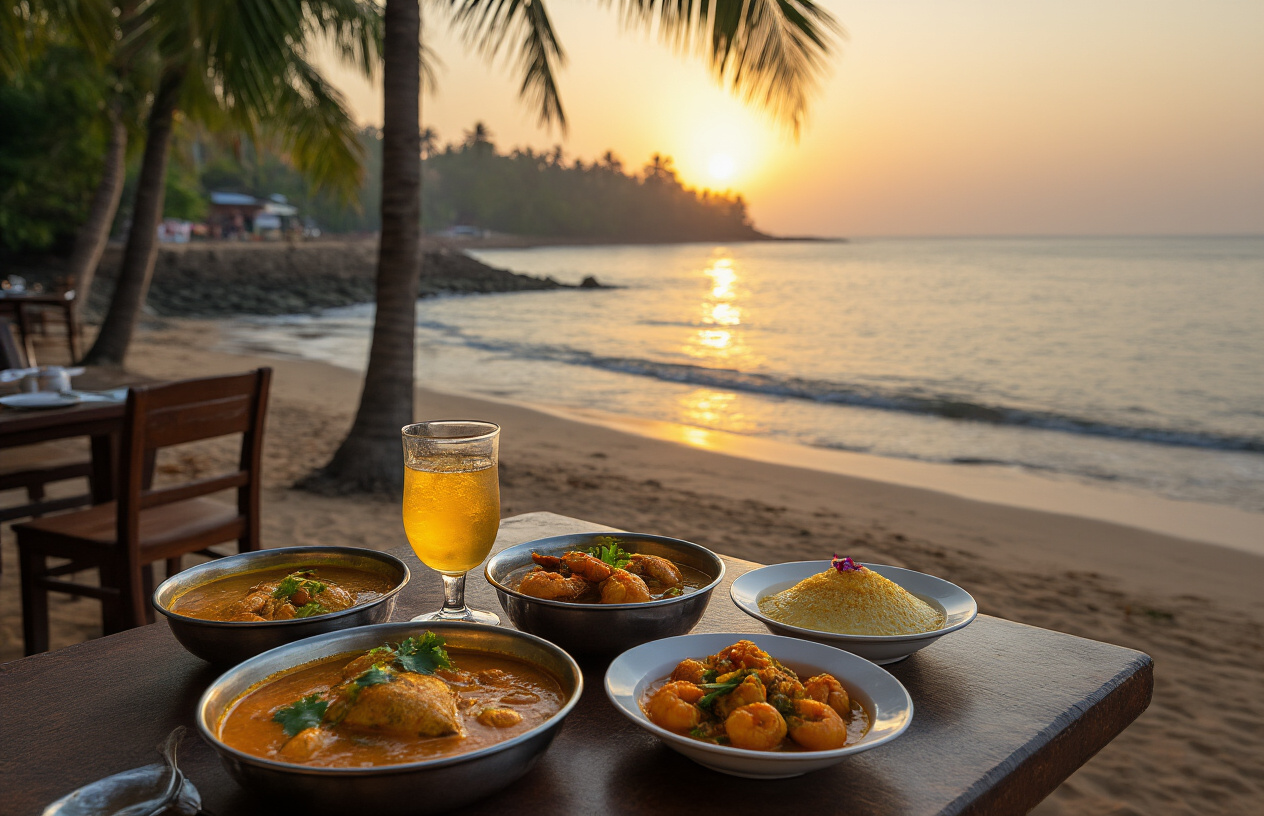
A. Seafood Delicacies: Where to Find the Freshest Catch
Goa’s seafood scene is absolutely mind-blowing. Skip the fancy restaurants and head straight to Anjuna Beach where Martin’s Corner serves up prawns so fresh they were swimming this morning. Trust me on this.
The locals hit Souza Lobo in Calangute when they want authentic fish curry. Their pomfret is legendary – cooked in that perfect tangy coconut gravy that’ll make you lick your fingers clean.
Want something different? Try Fisherman’s Wharf in Cavelossim. Their crab xacuti will change your life. They crack those suckers right in front of you – messy but worth every napkin.
Morning people should check out the Mapusa Fish Market around 7 AM. You’ll see Goan mamas haggling over kingfish and red snapper. It’s chaotic, smelly, and absolutely real.
B. Goan Cuisine: Must-Try Traditional Dishes
You haven’t done Goa if you’ve missed vindaloo. But not that British takeaway nonsense. Real vindaloo has a sharp vinegar punch that cuts through the pork perfectly.
Xacuti (pronounced sha-koo-tee) is another knockout. It’s this ridiculously complex curry with over 20 spices. The chicken version at Mum’s Kitchen in Panjim is the gold standard.
Sorpotel isn’t for the faint-hearted. This dish uses every part of the pig and slow-cooks it with spices until it’s dark and intense. Pair it with sannas (fluffy rice cakes) for the full experience.
Vegetarians, don’t worry! Goan mushroom curry will blow your mind. The coconut-based gravy soaks into those mushrooms perfectly.
C. Beach Shacks vs. Fine Dining: Options for Every Budget
Beach shacks win on vibes alone. Sand between your toes, cold beer in hand, and a plate of butter garlic prawns for under 500 rupees. Curlies at Anjuna Beach is the classic choice – nothing fancy but damn good food.
Mid-range spots like Brittos at Baga Beach give you proper tables and chairs without the stuffiness. Their seafood platter feeds two hungry people for about 1200 rupees.
For those special nights, Gunpowder in Assagao turns Goan ingredients into art. Not cheap at 2500 rupees per person, but their Kerala-inspired seafood is worth every rupee.
The real winner? Ritz Classic in Panjim. It looks nothing special, but locals queue up for their fish thali. At 300 rupees, it’s the best value meal in Goa.
D. Feni Tasting: Experiencing Goa’s Local Liquor
Feni hits like a truck. This local firewater comes in two varieties – cashew and coconut. Both hover around 40-45% alcohol but taste completely different.
Cashew feni has this fruity, almost musky flavor that’s weirdly addictive. The best stuff comes from small-batch distillers in South Goa. Try Cazulo Premium for a smooth introduction.
Coconut feni tastes milder but don’t be fooled – it’s just as potent. It mixes brilliantly with lime soda for a beachy cocktail that’ll sneak up on you.
Want the real experience? Head to Vaz Liquors in Candolim where they’ll let you sample different ages and styles. Just don’t plan anything important for the next morning.
Practical Travel Tips for Goa Visitors
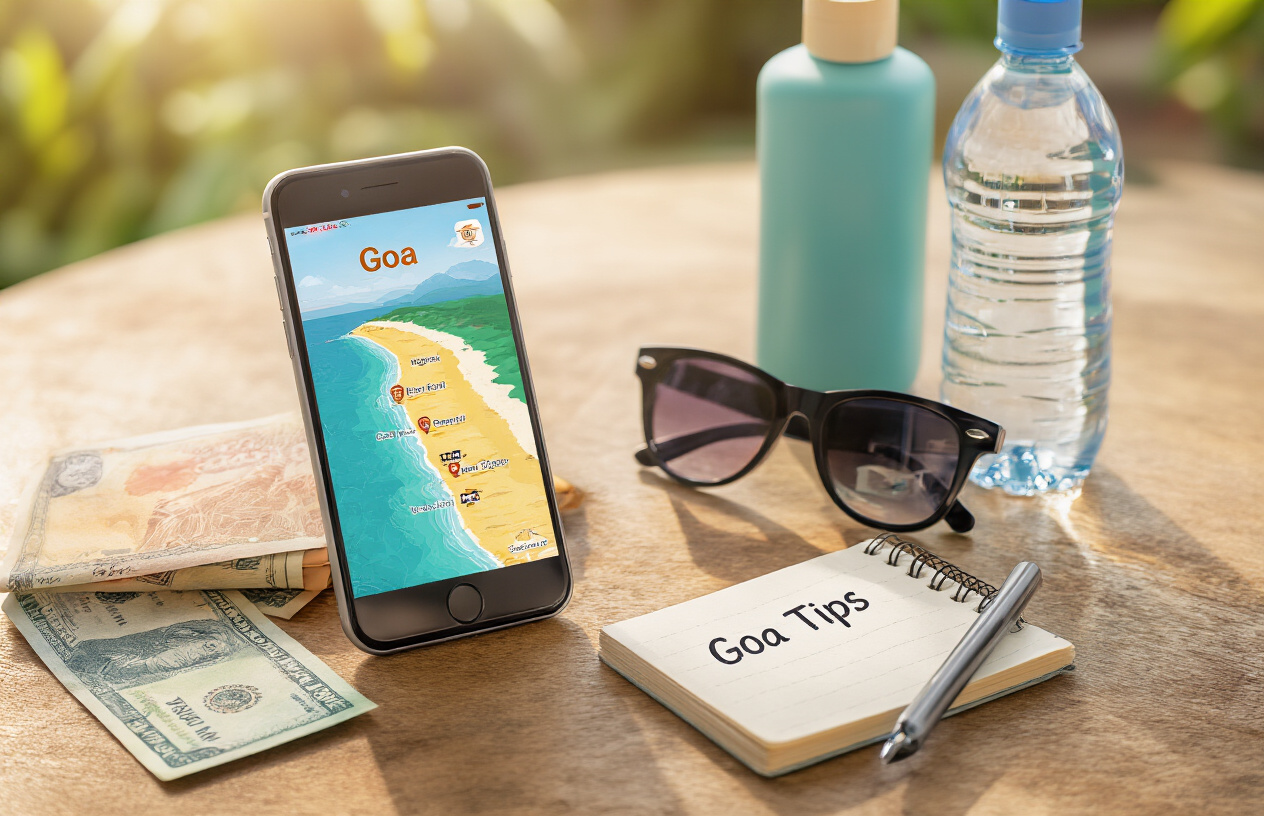
Transportation Options: Getting Around Efficiently
Goa isn’t huge, but getting around can make or break your trip. Renting a scooter? Absolute game-changer. For about ₹300-400 daily, you’ll zip through coastal roads feeling that perfect sea breeze. Just remember to carry your license and wear a helmet (police checks are common).
Taxis work too, but they’ll cost you. Negotiate hard before getting in or you’ll be shelling out tourist prices. The Goa Miles app is your friend here – fixed rates, no haggling needed.
For budget travelers, local buses are dirt cheap (₹10-30 per ride) but patience is required. They’re slow, crowded, and schedules are… suggestions at best.
Pro tip? Rent a bike for your entire stay rather than daily. You’ll save cash and skip the morning rental hustle.
Accommodation Choices: From Luxury Resorts to Budget Hostels
Your accommodation vibe sets the tone for your Goa experience.
North Goa people tend to splash out on beachfront hotels in Baga and Calangute (₹3,000-15,000/night). The convenience is unbeatable – step from your room straight to the beach.
South Goa attracts luxury seekers. Those five-star resorts in Cavelossim and Mobor? Pure bliss with private beaches and infinity pools (₹8,000-30,000/night).
Backpackers, head to Anjuna and Arambol. Hostels run ₹400-800 per night, and you’ll instantly connect with fellow travelers.
Beach huts in Palolem and Agonda offer middle-ground options (₹1,500-3,000/night) – basic but with unmatched ocean views.
Booking ahead is non-negotiable during peak season (December-January). Show up without reservations and you’ll either find nothing or pay triple.
Water Activities and Adventure Sports: Seasonal Availability
The ocean isn’t always your playground in Goa – timing matters.
October to May delivers perfect water sport conditions. Parasailing in Baga (₹1,200-1,800), jet skiing in Calangute (₹800-1,200), and banana boat rides everywhere (₹300-500 per person) run full swing.
Diving enthusiasts, Grande Island calls between November and April. Visibility peaks then, and you’ll spot colorful reef fish and maybe even sea turtles (₹4,000-6,000 for beginners).
Monsoon season (June-September) shuts down most water activities. Red flags on beaches aren’t suggestions – they’re warnings. The Arabian Sea gets angry, with dangerous currents and massive waves.
White water rafting, however, only happens during monsoons on the Mhadei River (₹1,800-2,500). The rapids come alive when everything else shuts down.
Shopping Guide: Markets, Boutiques and Souvenirs
Shopping in Goa isn’t about malls – it’s about character-filled markets and quirky boutiques.
Anjuna Flea Market (Wednesdays only) is chaotic magic. Haggle hard for everything from Kashmiri handicrafts to hippie clothing. Start at half their asking price.
Arpora Night Market (Saturday nights) combines shopping with live music and food stalls. The vibe alone is worth the trip.
For quality over kitsch, boutiques in Assagao and Fontainhas sell gorgeous resort wear and home décor. Pricier, but unique pieces you won’t find elsewhere.
Must-buy souvenirs? Goan spices (especially recheado and xacuti masalas), cashews (cheaper than anywhere else in India), feni (local cashew/coconut liquor), and azulejos (Portuguese-style tiles).
Safety Considerations: Beach Rules and Local Customs
Goa feels laid-back, but staying safe requires some common sense.
Beach shacks close by sunset for good reason. Swimming after dark is dangerous – invisible currents have claimed many lives. Those color-coded flags? Respect them: red means absolutely no swimming.
Drugs are heavily policed despite Goa’s party reputation. Undercover cops are everywhere, and Indian drug laws are no joke.
Dress code varies by location. Tourist beaches allow bikinis, but when visiting villages or temples, shoulders and knees should be covered.
Respect the locals’ pace of life. “Sussegad” isn’t just a saying but a philosophy – slow down, be patient, and avoid typical big-city rushiness.
Never leave drinks unattended at beach parties, and use registered taxis for late-night travel. Solo female travelers should exercise standard precautions, especially in isolated areas after dark.
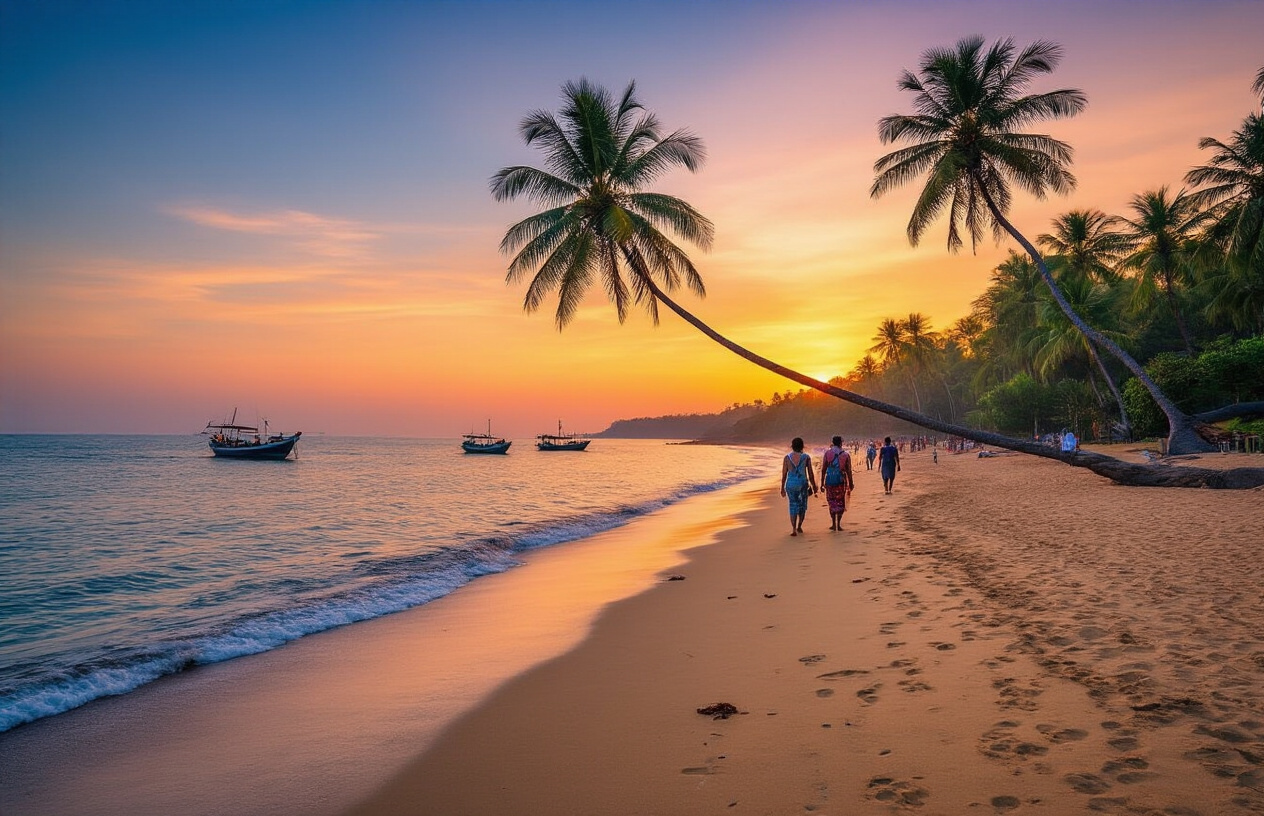
Goa offers a paradise for every traveler throughout the year, with October to March being the ideal time to visit for perfect beach weather and festivities. Whether you seek the vibrant energy of North Goa’s popular beaches and nightlife, or the tranquil atmosphere of South Goa’s pristine shores, this coastal gem delivers unforgettable experiences. Beyond its famous beaches, Goa’s rich Portuguese heritage, historic churches, and spice plantations provide cultural depth worth exploring.
Pack light, respect local customs, and consider renting a scooter to truly experience Goa’s charm at your own pace. From savoring authentic Goan fish curry to participating in colorful festivals, this tiny state on India’s western coast promises memories that will last a lifetime. Start planning your Goan adventure today and discover why this destination continues to captivate travelers from around the world.

